Canon IXUS 1100 HS Review
Canon IXUS 1100 HS
Does Canon's latest IXUS flagship touch-screen compact deliver?
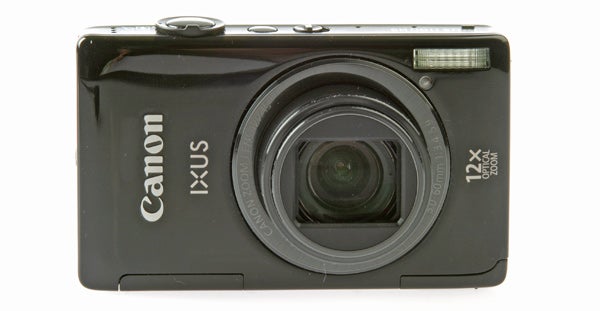
Verdict
Pros
- Big zoom, compact size
- Good image quality
- Solid low-light performance
Cons
- Touch-screen control is slow and fiddly
- Lacks semi/fully manual control
- Lacks a finger grip
Key Specifications
- Review Price: £370.00
- 12.1-megapixels
- 12x optical zoom
- ISO 100 - 3200
- 1080p Full HD movie recording @ 24fps
- 3.2in PureColour II touch-screen LCD
The new model looks to improve on all of the IXUS 1000 HS’s primary specs, with incremental increases in overall resolution, telephoto reach and LCD screen size. In addition, it also sheds most of its physical buttons to offer almost complete touch-screen control. All this, and yet Canon is still able to claim that the IXUS 1100 HS is the “world’s slimmest camera with a 12x optical zoom”.

And it’s not just the headline specs that have changed, either. Keeping pace with the latest trends, the 1100 HS also features a range of digital effects filters, along with a new Movie Digest shooting mode that automatically records snippets of video every time you take a photo, blending all of the snippets into a single video at the end of every day.
In addition, the 1100 HS also has a new Intelligent IS (Image Stabilisation) system whereby the camera is able to analyse the scene before selecting the most appropriate type of stabilisation from seven options, including ones specifically designed for use while recording movies.
As with its predecessor, the 1100 HS sticks with the same tried and tested HS (High Sensitivity) system that combines a backside illuminated CMOS sensor with Canon’s DIGIC 4 processor to minimise noise in low-light, high-sensitivity situations.
Given all the changes and upgrades the IXUS 1100 HS looks like quite an impressive camera on paper. But how does it handle in real life? Let’s take a closer look and find out…
The 1100 HS is built around a 1/2.3in backside-illuminated CMOS sensor producing 12.1MP of effective resolution, with images processed by Canon’s DIGIC 4 chip. This sensor and image processor combination forms the HS (High Sensitivity) part of the product name, being specifically designed to work together to improve overall image quality in low light by minimising the effects of noise. 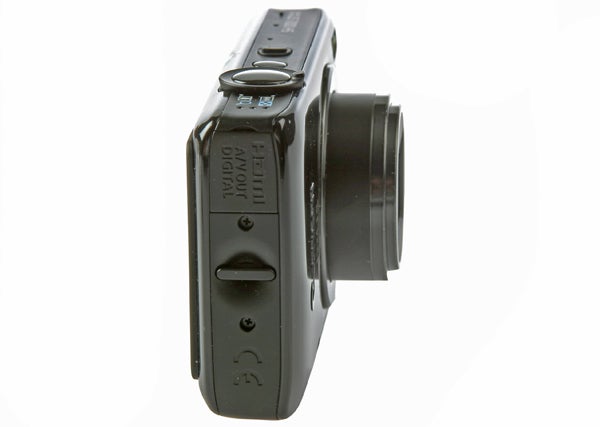
For those new to the concept of backside-wired sensors, the idea behind them is actually quite simple. Reduced to its most basic level, a digital camera sensor is basically an array of light-sensing diodes. These need to be wired together so that the camera’s able to cross-process the data from all of them in order to create an image.
On regular sensors this wiring sits on top of the sensor, which has the effect of blocking some of the light. Backside-illuminated sensors, on the other hand, place all this wiring underneath the chip, which allows more light to hit the individual diodes, resulting in a stronger signal.
In addition to its backside-wired sensor and latest generation image processor, the 1100 HS offers a standard sensitivity range of between ISO 100 and ISO 3200 – exactly the same as the 1000 HS before it. There’s also a dedicated High Sensitivity shooting mode that pushes sensitivity up to ISO 6400 albeit at a reduced resolution of 3MP.
Whereas the 1100 HS’s predecessor sported a 10x optical zoom, the new model increases this to 12x, with a focal range equivalent of between 28mm and 336mm in 35mm terms. Maximum aperture of this lens remains at f/3.4 at 28mm, stopping down to f/5.9 by 336mm. In addition to its regular Optical Zoom capabilities, the 1100 HS allows you to apply either a 1.5x or 2.0 digital teleconverter that combines with Image Stabilisation (IS) support to produce usable shots up to a maximum 24x, or a combination of the two without IS up to a maximum 48x.
The new model offers a good range of shooting modes, although given that its £350 price tag puts it well into advanced compact territory we’re a little disappointed not to find the full range of PASM controls available. Indeed, the 1100 HS is very much from the point-and-shoot stable. You do get a Program mode that allows for a good range of user input in areas like metering, My Colours colour profile, white balance and ISO. However, aperture and shutter combinations are calculated and decided entirely by of the camera at all times, giving you limited creative control.
There’s no kind of simplified background defocus tool either, which means there’s no way to control depth-of-field. And no dedicated ‘Sports’ shooting mode either, at least not at the camera’s full 12.1MP resolution. There is a High-speed Burst mode that shoots at 8fps, but this reduces resolution to a rather measly 3MP. Canon has seen fit to offer the likes of Portrait, Handheld NightScene and Kids&Pets scene modes though, all of which can be directly selected from the shooting mode menu. And of course, there is a fully automatic Smart Auto mode too, which thankfully (though rather oddly at first) is accessed directly via a physical two-way switch on top of the camera.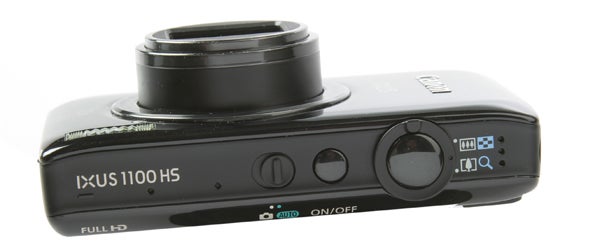
One other useful, if not particularly new feature, is Smart Shutter mode. This allows the camera to be triggered by a smile, a blink or even when a new face enters the frame – which could be useful for group portraits. Last but not least, is the all-new Movie Digest mode that records a brief three-second movie clip every time a still image is taken, automatically combining all of these clips into a single movie that reflects all of the still images taken that day. It’s an interesting idea and one that Nikon appears to be keen to pursue too via the Motion Snapshot feature in its new J1 and V1 CSC models.
Video recording abilities are well catered for, with the 1100 HS able to record 1080p Full HD movies at 24fps with stereo audio, with resultant files encoded in the H.264 format. Should you need to save space on your memory card then the 1100 HS also offers 720p and 640 x 480 recording options. In addition, the 1100 HS also supports Apple’s 720p iFrame encoding format that allows videos to be edited in software such as iMovie and Final Cut without prior conversion. Last but not least, are a couple of slow-motion video modes that record at 120fps and 240fps at a reduced maximum resolution of 640 x 480 and 320 x 240, respectively.
As a style-led IXUS model, the 1100 HS benefits from an all-metal casing that gives it an unmistakably premium feel. At 206g with a battery and card it’s reassuringly weighty for a compact too. Aesthetically, it’s quite a bit different from its predecessor not least on account of having lost all traces of a D-pad and most other physical buttons to accommodate the large touch-screen. Corners and edges have been softly rounded off, but have lost the chiselled-off look of the 1000 HS.
Overall, we rather like the new profile. While it’s slightly more of a traditional soap-bar shape, and certainly a lot less angular than the 1000 HS, it remains a very sleek and stylish camera – just as you might expect from an IXUS model.
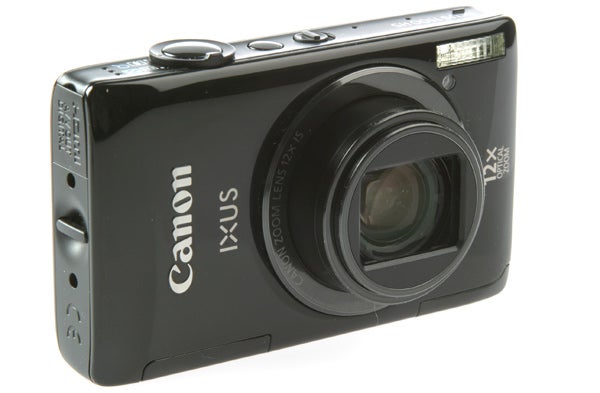
Even though the Canon logo on the front is embossed, there’s no proper handgrip, and while the back of the camera does get a plastic strip with a raised edge that’s slightly easier to grip than the shiny metal front, it’s not perfect. Thankfully Canon does supply a wrist strap in the box, and we’d suggest anyone who buys a 1100 HS makes good use of this.
In order to accommodate the enlarged touch-screen, physical controls have been stripped back to the bare minimum. Indeed, the camera only has four buttons in total: an On/Off switch, the Shutter button (which is encircled by the camera’s spring-loaded zoom control), a Playback button and a two-way switch that allows you to choose between the camera’s various user-defined shooting modes and fully Automatic mode.
On the back, the 1100 HS sports a 3.2in, 461k-dot PureColor II LCD touch-screen. While this monitor serves up a bright and colourful image that remains visible in bright sunlight, the resolution is a little low for a camera costing in excess of £350. While the 1100 HS’s 461k-dot screen is noticeably sharper than the basic 230k-dot screens used in the vast majority of cheap compacts, for £370-odd it wouldn’t have been entirely unreasonable to expect a 921k-dot monitor. Perhaps Canon is saving that particular upgrade for the IXUS 1200 HS.
In addition to image composition and playback duties, the rear LCD touch-screen also serves as the main control point for the camera. From the main shooting screen it’s fairly easy to get to where you want using the square icons on either side of the screen. For example, to move from Program to say, Smart Shutter mode, you simply tap the ‘P’ in the top-left and then the large Smart Shutter icon from the resultant sub-menu.
If, you want to make more advanced changes, including to settings then the FUNC icon (bottom-left) acts as the entry point to both the advanced menu (accessed via a further screen-jab on the Menu icon) and also serves up a quick menu along the left-hand side of the screen to access and change shooting settings. It’s a simple enough system to navigate at the top level, however we did find that once you leave the large square icons behind and start scrolling through the specific options the touch-screen does become more fiddly.
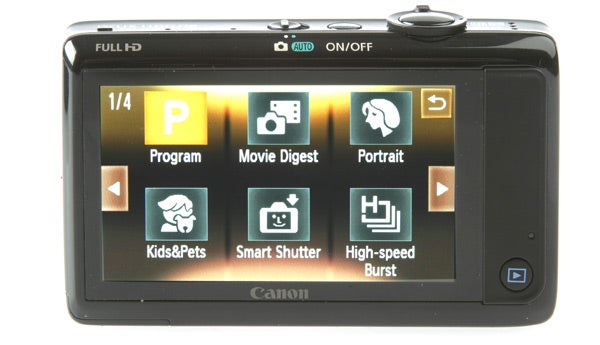
It’s not that it’s unresponsive, on the contrary we found the resistive screen responded quite well to fingers (gloved or ungloved) and pens alike. You can even scroll through the various options by using your finger on the other side of the screen to where the options are listed, although in practice this makes it much harder to land on the specific option you want.
Indeed, after a while we found that the best way to get where we wanted was to tap our way through the choices one icon at a time. This does slow things down quite considerably though, making overall navigation of the 1100 HS painfully slow at times. To put it another way, if your smartphone was this slow and fiddly to navigate you’d probably want to swap it for something else.
Two new additions to the 1100 HS that are specifically made possible by the touch-screen and which we do rather like are the Touch AF and Touch Shutter functions. Switched on via the icon on the right-hand side of the screen, Touch AF allows you to select a point of focus simply by tapping it on the screen. Taking things one step further, Touch Shutter automatically records an image once focus has been established and your finger removed. While both features give you a degree of creative control it’s a shame there’s no direct depth-of-field control that would allow you to use them even more creatively.
Start-up speed clocks in at around three and a half seconds, and while this is hardly speedy it’s fairly standard for a compact camera of this type. Continuous shooting at the full 12.1MP resolution clocks in at a rather slow 1fps, but there’s no upper limit on the number of shots that can be taken. Switching to High-Speed Burst mode lowers resolution to 3MP but raises continuous shooting to just under 8fps. While in this mode we were able to record 210 images in 30secs without experiencing any slowdown. Impressive stuff, but a quick access mode that sits somewhere between these two extremes would probably be more useful.
As with the majority of Canon compacts we’ve tested in the past, the IXUS 1100 HS delivers consistently high image quality.
Used with the My Colours colour profile switched off, the 1100 HS delivers neutral images that, while lifelike and accurate, can be a bit flat tonally. Trying out the various My Colours colour profile options, we found the Vivid to be slightly too saturated for our tastes, while the Neutral setting was a bit flat.
The Positive Film option, however, occupied just the right space for us, mimicking the look of colour film with bold (but not overly saturated) colour and rich tones. Of course, these things are entirely subjective, and the My Colours menu offers something for everyone.

The various shooting modes offered by the 1100 HS all have their time and place, but for general day-to-day shooting we found ourselves drawn to Program mode thanks mostly to the additional control on offer. That said, we did notice that switching over to Smart Auto mode to photograph exactly the same scene often produced quite different results.
The reason for this is that, rather than just selecting an aperture/shutter combination, the 1100’s Smart Auto mode actually analyses what’s before it before selecting what it deems to be an appropriate Scene mode (from 32 options), which will often mean choosing a different My Colours setting too. In Program, Smart Auto and the various Scene modes alike we encountered no problems with Automatic White Balance performance.
While dynamic range is about what we’d expect from a compact – i.e. not brilliant – metering is mostly spot on, especially in even or flat lighting conditions and in scenes that offer little in the way of contrast. In high-contrast situations the camera treads a good balance between highlights and shadows as far as its dynamic range will allow, with the latter particularly well looked after by the i-Contrast (shadow detail preservation) tool that can be switched on in the main menu. For more robust manual intervention, the 1100 HS also offers /-2EV of exposure compensation. 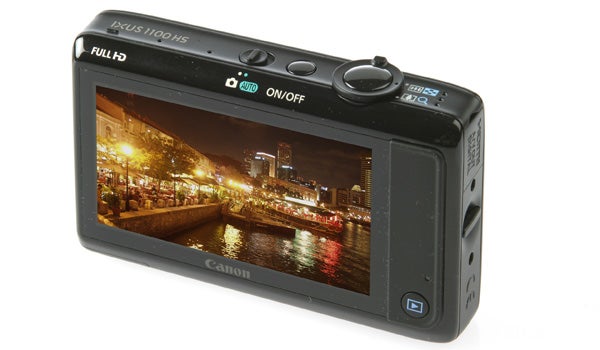
The 12x optical zoom offers a generous degree of flexibility while out shooting and delivers good sharpness in the middle of the frame, although detail does get softer towards the edges and corners of the frame. This is more pronounced when the camera is used at 28mm. A small amount of barrel distortion is also noticeable at 28mm, although this quickly corrects itself as you move through the focal range. We did notice some instances of purple and cyan fringing on high-contrast borders too.
Noise is well controlled in the lower sensitivity settings of ISO 100-400, but does become significantly more noticeable above this, even when images are reduced in size. If you’re shooting images that are only going to be reproduced on-screen at a maximum 30% of actual size (which, in the case of the 12.1MP IXUS 1100 HS, is still large enough to comfortably fill a 15in laptop screen) then it’s possible to produce useable images at ISO 800 and 1600, although some grain and a slight softening of detail is visible. Images shot at the top setting of ISO 3200, though, display a substantial loss of detail along with a noticeable reduction in colour, which is noticeable even when viewed at 15% (about the same size as the images in our Sample Gallery).
Verdict
The Canon IXUS 1100 HS is a stylish and well-made touch-screen compact that offers good point-and-shoot usability, a generous zoom range and a decent, if not quite class-leading, range of shooting features. While touch-screen control remains a nice idea in principle, in practice it does slow overall operation of the camera down quite considerably. That’s a shame because, touch-screen control issues aside, the IXUS 1100 HS is a very competent and stylish camera. Given its fairly high launch price we wouldn’t expect it to hold much appeal beyond those particularly averse to normal physical controls. However, should the street price drop below £300 then it’s likely to find much more mass appeal.

ISO 100

ISO 200

ISO 400

ISO 800

ISO 1600

ISO 3200

At 28mm the 1100 HS isn’t the widest compact on the market.

At 336mm, however, the built-in Image Stabilisation does a pretty good job of keeping things sharp.

The 1100 HS is a reliable point-and-shoot compact.

It’s possible to take passable shots for the web, or for viewing at smaller sizes, at ISO 1600.

The 1100 HS also offers a dedicated Low-Light Mode, although resolution does drop to 3MP.

We like the added punch of the Positive Film ‘My Colour’ setting.

Naturally, the digital filters on offer include a Miniaturisation effect…

…along with a Toy Camera effect.

We’re not so taken with the Posterisation effect though.

There’s also a Macro mode, although it isn’t the best we’ve seen on a compact.
Trusted Score
Score in detail
-
Value 7
-
Design & Features 8
-
Image Quality 9
-
Build Quality 8
Features
| Camera type | Digital Compact |
| Megapixels (Megapixel) | Megapixel |
| Optical Zoom (Times) | 12x |
| Image Sensor | CMOS |
| Image Stabilisation | Optical |
| LCD Monitor | 3.2" |
| Flash modes | Auto Flash |
| Video (max res/format) | 1920 x 1080 |

